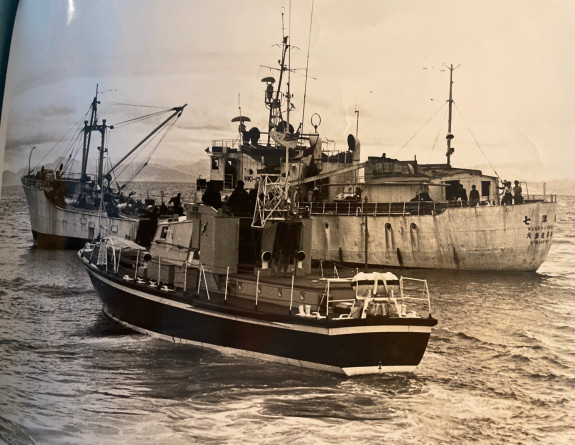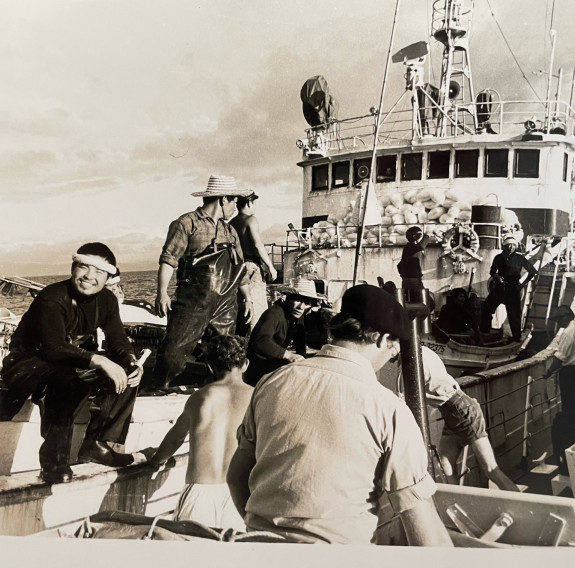Fisheries protection and more in the 1950's, 60's and 70's
From the mid-1950s to late 1970s 400-ton Japanese long-liners would work New Zealand’s coastline. Keeping them honest fell in large part to four RNZN Seaward Defence Motor Launches (SDML) of the fisheries protection squadron.
23 June, 2023
Former Commanding Officer Brian Petley relates his adventures.
In 1943 and 1944 15 Harbour Defence Motor Launches were shipped to New Zealand and by the 1950s the Navy had the largest active fleet of MLs still in existence. A generation of officers and sailors were acquainted with them, and probably two generations of reservists.
Reclassed as Seaward Defence Motor Launches after the war, they were attractive boats and quite seaworthy, sporting a signature black hull, white stripe and grey superstructure and radar by the 1960s (except for the two white survey motor launches Tarapunga AND Takapu). They started out as a Lieutenant’s drive but fairly rapidly became a Sub Lieutenant’s drive. Oh, so young to have an independent command!
The squadron’s four SDMLs were HMNZ Ships Haku, Kahawai, Maroro and Mako, although a reservist motor launch could be swapped in. There was a comfortable cabin aft for the skipper, (right above the propellers which meant not much sleep while underway) and a two-berth cabin for the Petty Officer Cox’n and Petty Officer Stoker. Crew mess was forward for two able seamen, two stokers, one radio operator and one electrician. Not much sleep there either, with the bow usually pitching up and down in the swell, but we were all young and pretty much invincible.
We had a small galley with a one-ton cast iron diesel-fired stove (another story on its own!), and small, well-appointed wheelhouse/chartroom.



Photography and newspaper clippings (The Dominion) from Brian Petley's personal collection.
Everything was very basic but worked well (most of the time). The ships had been re-engined with six-cylinder marinized Foden bus engines, very reliable, and two had 12 cylinder Fodens for an extra one knot of speed and nearly double the fuel consumption. Being twin screw, they were easy to drive and a dream to manoeuver, with very responsive hydraulic gearboxes and hydraulic steering.
For a three or four week fisheries patrol the Cox’n, being in charge of victualing, would supervise loading stores. I would grab some money and pay from HMNZS Philomel, the latest crypto cards (classified cards to exchange classified information), then away we would go. It was always nice to escape from the naval base, and things were pretty informal onboard when on patrol. I would always do the first and morning watch, and bounce down into the crew mess at 7am inquiring what was for breakfast. Usually I was greeted with a muffled voice from under a cover, “get your f--- own….sir”. Somehow the “sir” always seemed to be an afterthought. I rapidly learned to live on two Weetbix slapped together with honey - fast, filling and nutritious. The food was usually pretty good and depended to a large extent on the Cox’n who would crack the whip.
We were more or less left to our own devices. If you spent too much time in harbour there would be an inquiry from the Staff Officer Operations asking why you were not at sea on patrol. A couple of crayfish delivered to SOO on return to Auckland would make up for many minor transgressions.
We suspected the Japanese longliners had a radar detection receiver and were aware of our proximity. To counter it I would make sure the Cox’n had the boat a couple of miles off the beach at the end of his middle watch. I would move inshore until I could hear the waves breaking on the beach, then switch the radar off and navigate by the sound of the surf. We would creep along aiming to be off a river mouth (where the fishing was best) by sunrise. It was a bit like the cat stalking a mouse.
Near Whakatane, we caught three dories (small shallow draft boats) pulling in their lines and preparing to rejoin their mother ship 12 miles out.
“GOTCHYA!” We did a quick round up and navigation fixes (they were only a mile off the beach and in clear violation) and towed them into Whakatane to be placed under arrest. The poor mother ship anchored off the entrance some hours later. We waited two days while the Magistrate got his act together and subsequently fined the Japanese captain $10,000 and expelled the boat from NZ waters!
The Captain pleaded poverty and said he couldn’t pay the fine. So the good people of Whakatane, feeling sorry for the destitute fishermen being pushed around by the Navy, did a quick whip round and paid the fine for him.
Six months later I met the same Captain in a different (and legal) vessel in Golden Bay, transferring his catch to a cargo ship. He recognized me straight away and with a cheesy grin held up a large tuna and a bottle of sake. Such are the spoils of war.
We also had to police the local fishermen who were a pretty cantankerous lot and did not appreciate the government’s interference in their operations. We would lift their crayfish pots to check for size, and always leave a bottle of beer or two for any crayfish taken out. They knew the Navy had been around and doing their job.
We would frequently anchor at Mayor Island to cook up a good hot meal and, if staying overnight, visit the big game fishing club, where we all drank Bacardi and coke by the jug! We’d have six hours uninterrupted sleep, then off again at about 4am for another round of the Bay of Plenty.

Photography (The Dominion) from Brian Petley's personal collection.

Photography (The Dominion) from Brian Petley's personal collection.

Photography (The Dominion) from Brian Petley's personal collection.

Photography (The Dominion) from Brian Petley's personal collection.
When the P-3 Orion aircraft was introduced in the mid-1960s it added another arm to the foreign fishing issue. A wonderful aircraft, it really came into its own patrolling the 200-mile Exclusive Economic Zone from the 1970s. Unlike us, the aircrew had a nice bar and a warm bed to go home to after a day’s work. The P-3 was great for surveillance but only the Navy could do enforcement and boardings.
There was plenty of other work for the boats. Once it was Department of Conservation counting tuatara lizards on Cuvier and the Mercury islands (a navigation nightmare), another time with Victoria University volcanologists surveying the crater on White Island. We took journalists to sea, escorted the Royal Yacht into Auckland, did Waitangi day transport, port visits all over New Zealand, acted as the loyal opposition during fleet exercises and conducted search and rescue. The list goes on.
We had our share of mishaps. Three days after taking command we put HMNZS Haku on the Wairoa Bar. We lost five feet of the starboard bow rub rail in a gale off Kaikoura, and hit a log in the South Taranaki bight one wild night, bending a propeller shaft, which caused us to limp into Wellington on one engine and spend four days on the Evans Bay slip.
After 11 months I had to return to the real Navy at the end of 1970, spending most of the next 15 years in the ops room of various frigates, both Royal Navy and Royal New Zealand Navy.
